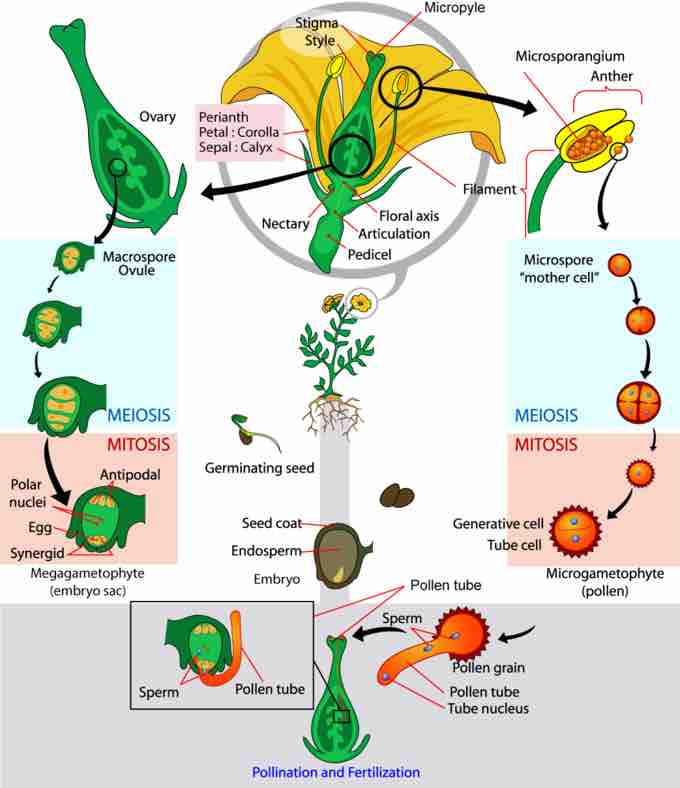The Life Cycle of an Angiosperm
The adult, or sporophyte, phase is the main phase of an angiosperm's life cycle . As with gymnosperms, angiosperms are heterosporous. Therefore, they generate microspores, which will produce pollen grains as the male gametophytes, and megaspores, which will form an ovule that contains female gametophytes. Inside the anthers' microsporangia, male gametophytes divide by meiosis to generate haploid microspores, which, in turn, undergo mitosis and give rise to pollen grains. Each pollen grain contains two cells: one generative cell that will divide into two sperm and a second cell that will become the pollen tube cell.

Life cycle of angiosperms
The life cycle of an angiosperm is shown. Anthers and carpels are structures that shelter the actual gametophytes: the pollen grain and embryo sac. Double fertilization is a process unique to angiosperms.
The ovule, sheltered within the ovary of the carpel, contains the megasporangium protected by two layers of integuments and the ovary wall. Within each megasporangium, a megasporocyte undergoes meiosis, generating four megaspores: three small and one large. Only the large megaspore survives; it produces the female gametophyte referred to as the embryo sac. The megaspore divides three times to form an eight-cell stage. Four of these cells migrate to each pole of the embryo sac; two come to the equator and will eventually fuse to form a 2n polar nucleus. The three cells away from the egg form antipodals while the two cells closest to the egg become the synergids.
The mature embryo sac contains one egg cell, two synergids ("helper" cells), three antipodal cells, and two polar nuclei in a central cell. When a pollen grain reaches the stigma, a pollen tube extends from the grain, grows down the style, and enters through the micropyle, an opening in the integuments of the ovule. The two sperm cells are deposited in the embryo sac.
A double fertilization event then occurs. One sperm and the egg combine, forming a diploid zygote, the future embryo. The other sperm fuses with the 2n polar nuclei, forming a triploid cell that will develop into the endosperm, which is tissue that serves as a food reserve. The zygote develops into an embryo with a radicle, or small root, and one (monocot) or two (dicot) leaf-like organs called cotyledons. This difference in the number of embryonic leaves is the basis for the two major groups of angiosperms: the monocots and the eudicots. Seed food reserves are stored outside the embryo in the form of complex carbohydrates, lipids, or proteins. The cotyledons serve as conduits to transmit the broken-down food reserves from their storage site inside the seed to the developing embryo. The seed consists of a toughened layer of integuments forming the coat, the endosperm with food reserves, and the well-protected embryo at the center.
The fruit of the Aesculus or Horse Chestnut tree
These seeds are enclosed a protective outer covering called the seed coat, usually with some stored food. After fertilization and some growth in the angiosperm, the ripened ovule is produced. The formation of the seed completes the process of reproduction in seed plants (started with the development of flowers and pollination), with the embryo developed from the zygote and the seed coat from the integuments of the ovule.
Some species of angiosperms are hermaphroditic (stamens and pistils are contained on a single flower), some species are monoecious (stamens and pistils occur on separate flowers, but the same plant), and some are dioecious (staminate and pistillate flowers occur on separate plants). Both anatomical and environmental barriers promote cross-pollination mediated by a physical agent (wind or water) or an animal, such as an insect or bird. Cross-pollination increases genetic diversity in a species.